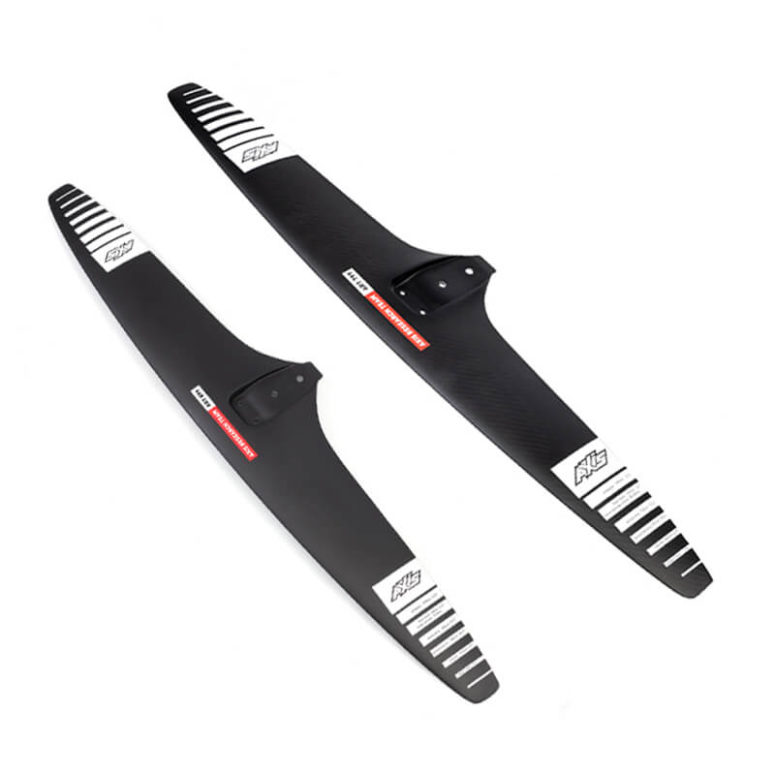

When you purchase gear through links on our site, we may earn a small commission. Here’s why you can trust our tests and our affiliate partner.

The AXIS ART 999 was the first to drop from the new Axis Research Team range and we were extremely impressed with its speed range and phenomenal levels of glide. Following on closely in its footsteps are two smaller siblings with reduced spans and areas, which carry overall the positive attributes of the cutting-edge ART 999 wing and improve maneuverability, and top end speed ranges.
Wingfoiling in positive conditions I was extremely impressed at how quickly the ART 899 got me going in the low end, even in comparison to the 999. What’s immediately apparent is the reduced span really frees up the roll axis, and where the 999 could occasionally feel a little limited around the bends, these two smaller wings, particularly paired with the new Progressive tail range, feel very free and lively. The extreme levels of glide found in the ART 999 remain, just your cruising speed and turning ability increase.
It was difficult to visualize using a foil setup this small for SUP even a year ago, and that’s a testament to how far surf foil design has come on in that short period. We paddled with the 899 and 400 setup, and I was extremely impressed with the pumping ability, even on a SUP. As long you achieve a decent take off, it was simple to maintain glide and speed.
These relatively close size increments also provide the added bonus of being able to tailor a quiver better for your bodyweight or intended usage. The 799 was my choice for higher wind winging. All attributes are turned up a notch again from the 899, with an obvious increase in top end. The interesting thing for me is that even a foil size I’d normally only consider kite foiling with is now socially acceptable for winging and felt lively under a relatively high volume board.
The smaller sizes in the ART range continue to make what you would expect to be a difficult to ride, twitchy, high-aspect foil far more accessible than you would anticipate, and the bandwidth of usability seems to increase as the sizes diminish. As a 90kg mixed discipline rider, the ART 899 is perhaps the one I’d take home. There’s something about that span that works well for me. This ekes out a little more top end when wing propelled and doesn’t compromise my low end much. The glide and speed improves and importantly the turning steps up a notch; it’s positive news all round.
The other excellent news from New Zealand is the new range of Progressive tail wings is tailored specifically to complement the new thinner profiled and high-aspect front wings from both the HPS and ART series, although it has compatibility across the whole range. The sizing spans from a 325 to 475 in 25mm increments, so in typical AXIS style there’s plenty of options to choose from to tailor to your weight and riding size. We primarily tested the mid-sized 375 and 400, both winging and SUP foiling. For the AXIS connoisseur, the Progressive tail is a fusion between the popular 390 GAP and some of their flatter, thinner wings like the 400HA. It’s got a teardrop shaped tip, mid-aspect ratio, thin foil shape and a slight anhedral curve running down into the tips.
This is perhaps the faster, more reactive, and most importantly, confidence-inspiring set of stabilizer options that AXIS users have been waiting for. Even with a fairly large SUP, more pivotal snappy turns were available, and as a bonus it seemed a little easier to maintain speed and glide when exiting them. Wingfoiling with a smaller board on top, I found these tails to access new levels of mobility in the system, and when going into a rapid carve at high speed on swell, there was a feeling of reassuring consistency through the turn where the flatter wings in the system could start to slide out. These stabilizers also seem to handle chop and turbulent water with more dignity, which is important when attached to a high performing front wing. The Progressive tails find a great balance between turning radius, grip and outright speed, and manifest a genuinely surfy feeling. RB
